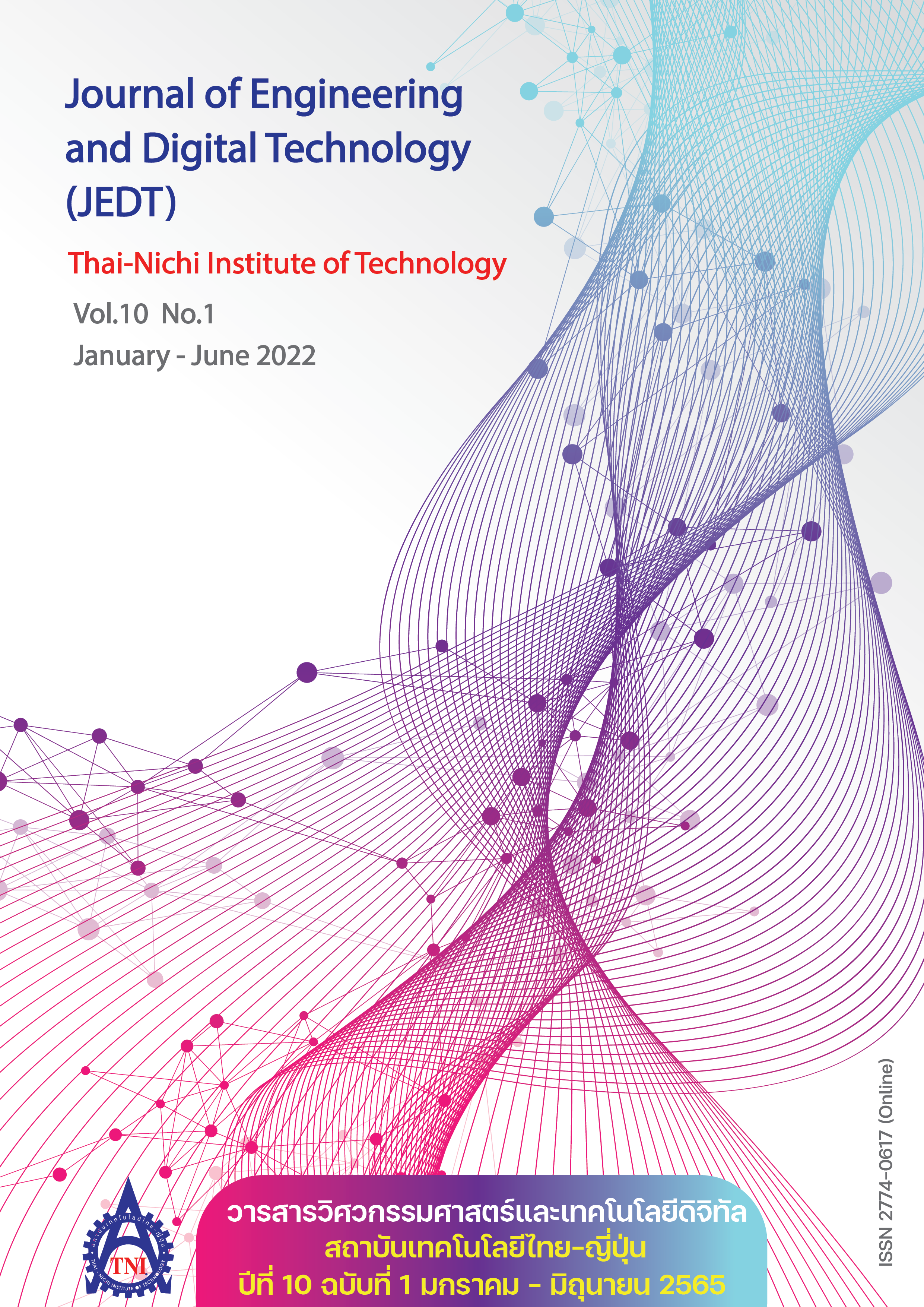แบบจำลองการพยากรณ์ค่า PM2.5 โดยใช้โครงข่ายประสาทเทียมแบบ LSTM ในพื้นที่กรุงเทพมหานคร
Main Article Content
บทคัดย่อ
PM2.5 ถือเป็นปัญหาสำคัญของประเทศไทยโดยเฉพาะในกรุงเทพมหานครและปริมณฑล ส่งผลกระทบอย่างมากมายต่อสุขภาพ เศรษฐกิจและสังคม การพยากรณ์โดยใช้แบบจำลองทางคณิตศาสตร์เพื่อตรวจสอบระดับความเข้มข้นของ PM2.5 เป็นทางเลือกที่ทำให้ทราบค่าประมาณของ PM2.5 งานวิจัยนี้นำเสนอวิธีโครงข่ายประสาทเทียมแบบหน่วยความจำระยะสั้นแบบยาวในการสร้างแบบ จำลองเพื่อใช้ในการทำนายปริมาณฝุ่นอนุภาคขนาดเล็กดังกล่าวบริเวณพื้นที่ทั่วไปและริมถนนในกรุงเทพมหานคร ใช้การวิเคราะห์สหสัมพันธ์คัดเลือกตัวแปรหลักเข้าสู่แบบจำลองและเกณฑ์ RMSE และ MAPE เป็นเครื่องมือวัดประสิทธิภาพการพยากรณ์ ซึ่งพัฒนาแบบจำลองที่แตกต่างกันได้ 8 แบบโดยอาศัยข้อมูลคุณภาพอากาศและข้อมูลอุตุนิยมวิทยา ผลการวิจัยพบว่าสำหรับพื้นที่ทั่วไปแบบ จำลองที่ 2 ที่ประกอบด้วยตัวแปร PM10, NO2, CO, O3, SO2 และ LAGPM2.5 เป็นแบบจำลองที่ให้ความแม่นยำสูงสุด ให้ค่าเฉลี่ย RMSE = 8.05, ค่าเฉลี่ย MAPE = 27.22 ส่วนพื้นที่ริมถนนแบบจำลองที่ 8 มีตัวแปร PM10, NO2, CO, Temp, Hum, Press, WindSp, WindDir และ LAGPM2.5 เป็นแบบจำลองที่เหมาะสมที่สุดให้ค่าเฉลี่ย RMSE= 4.83, ค่าเฉลี่ย MAPE = 22.57 แบบจำลองบริเวณริมถนน (แบบจำลองที่ 5-8) มีค่าผิดพลาดน้อยกว่าแบบจำลองในพื้นที่ทั่วไป (แบบจำลองที่ 1-4) และการพยากรณ์ที่ใช้ข้อมูลย้อนหลังเป็นระยะสั้น 1 วันมีแนวโน้มให้ผลลัพธ์ที่ถูกต้องมากขึ้น
Article Details

This work is licensed under a Creative Commons Attribution-NonCommercial-NoDerivatives 4.0 International License.
นโยบายการรับบทความ
กองบรรณาธิการวารสารสถาบันเทคโนโลยีไทย-ญี่ปุ่น มีความยินดีรับบทความจากอาจารย์ประจำ และผู้ทรงคุณวุฒิในสาขาวิศวกรรมศาสตร์และเทคโนโลยี ที่เขียนเป็นภาษาไทยหรือภาษาอังกฤษ ซึ่งผลงานวิชาการที่ส่งมาขอตีพิมพ์ต้องไม่เคยเผยแพร่ในสิ่งพิมพ์อื่นใดมาก่อน และต้องไม่อยู่ในระหว่างการพิจารณาของวารสารอื่นที่นำส่ง ดังนั้นผู้สนใจที่จะร่วมเผยแพร่ผลงานและความรู้ที่ศึกษามาสามารถนำส่งบทความได้ที่กองบรรณาธิการเพื่อเสนอต่อคณะกรรมการกลั่นกรองบทความพิจารณาจัดพิมพ์ในวารสารต่อไป ทั้งนี้บทความที่สามารถเผยแพร่ได้ประกอบด้วยบทความวิจัย ผู้สนใจสามารถศึกษาและจัดเตรียมบทความจากคำแนะนำสำหรับผู้เขียนบทความ
การละเมิดลิขสิทธิ์ถือเป็นความรับผิดชอบของผู้ส่งบทความโดยตรง บทความที่ได้รับการตีพิมพ์ต้องผ่านการพิจารณากลั่นกรองคุณภาพจากผู้ทรงคุณวุฒิและได้รับความเห็นชอบจากกองบรรณาธิการ
ข้อความที่ปรากฏภายในบทความของแต่ละบทความที่ตีพิมพ์ในวารสารวิชาการเล่มนี้ เป็น ความคิดเห็นส่วนตัวของผู้เขียนแต่ละท่าน ไม่เกี่ยวข้องกับสถาบันเทคโนโลยีไทย-ญี่ปุ่น และคณาจารย์ท่านอื่น ๆ ในสถาบัน แต่อย่างใด ความรับผิดชอบด้านเนื้อหาและการตรวจร่างบทความแต่ละบทความเป็นของผู้เขียนแต่ละท่าน หากมีความผิดพลาดใด ๆ ผู้เขียนแต่ละท่านจะต้องรับผิดชอบบทความของตนเองแต่ผู้เดียว
กองบรรณาธิการขอสงวนสิทธิ์มิให้นำเนื้อหา ทัศนะ หรือข้อคิดเห็นใด ๆ ของบทความในวารสารสถาบันเทคโนโลยีไทย-ญี่ปุ่น ไปเผยแพร่ก่อนได้รับอนุญาตจากผู้นิพนธ์ อย่างเป็นลายลักษณ์อักษร ผลงานที่ได้รับการตีพิมพ์ถือเป็นลิขสิทธิ์ของวารสารสถาบันเทคโนโลยีไทย-ญี่ปุ่น
ผู้ประสงค์จะส่งบทความเพื่อตีพิมพ์ในวารสารวิชาการ สถาบันเทคโนโลยีไทย-ญี่ปุ่น สามารถส่ง Online ที่ https://www.tci-thaijo.org/index.php/TNIJournal/ โปรดสมัครสมาชิก (Register) โดยกรอกรายละเอียดให้ครบถ้วนหากต้องการสอบถามข้อมูลเพิ่มเติมที่
- กองบรรณาธิการ วารสารสถาบันเทคโนโลยีไทย-ญี่ปุ่น
- ฝ่ายวิจัยและนวัตกรรม สถาบันเทคโนโลยีไทย-ญี่ปุ่น
เลขที่ 1771/1 สถาบันเทคโนโลยีไทย-ญี่ปุ่น ซอยพัฒนาการ 37-39 ถนนพัฒนาการ แขวงสวนหลวง เขตสวนหลวง กรุงเทพมหานคร 10250 ติดต่อกับคุณพิมพ์รต พิพัฒนกุล (02) 763-2752 , คุณจุฑามาศ ประสพสันติ์ (02) 763-2600 Ext. 2402 Fax. (02) 763-2754 หรือ E-mail: JEDT@tni.ac.th
References
Coconuts Bangkok. “2 Thai cities cracked world’s top 10 worst air pollution list this morning.” COCONUTS.co. https://coconuts.co/bangkok/news/2-thai-cities-cracked-worlds-top-10-worst-air-pollution-list-morning/ (accessed Feb. 28, 2022).
Prachachat. “PM 2.5 dust pushes Chiang Mai, the world's number 1 toxic air.” PRACHACHAT.net. https://www.prachachat.net/general/news-625935 (accessed Nov. 16, 2021).
A. Kurt, B. Gulbagci, F. Karaca, and O. Alagha, “An online air pollution forecasting system using neural networks,” Environ. Int., vol. 34, no. 5, pp. 592–598, Jul. 2008.
P. Perez, A. Trier, and J. Reyes, “Prediction of PM2.5 concentrations several hours in advance using neural networks in Santiago, Chile,” Atmos. Environ., vol. 34, no. 8, pp. 1189–1196, Jun. 2000.
D. Voukantsis, K. Karatzas, J. Kukkonen, T. Räsänen, A. Karppinen, and M. Kolehmainen, “Intercomparison of air quality data using principal component analysis, and forecasting of PM10 and PM2.5 concentrations using artificial neural networks, in Thessaloniki and Helsinki,” Sci. Total Environ., vol. 409, no. 7, pp. 1266–1276, Mar. 2011.
M. Opera, M. Popescu, and S. Mihalache, “A neural network based model for PM2.5 air pollutant forecasting,” in 20th Int. Conf. Syst. Theory, Control and Comput. (ICSTCC), Sinaia, Romania, Oct. 2016, pp. 776–781, doi: 10.1109/ICSTCC.2016.7790762.
C.-H. Ho et al., “Development of a PM2.5 prediction model using a recurrent neural network algorithm for the Seoul metropolitan area, Republic of Korea,” Atmos. Environ., vol. 245, Jan. 2021, Art. no. 118021.
Y.-T. Tsai, Y.-R. Zeng, and Y.-S. Chang, “Air Pollution Forecasting Using RNN with LSTM,” in IEEE 16th Intl. Conf. Dependable, Autonomic and Secure Comput., 16th Intl. Conf. Pervasive Intell. and Comput., 4th Intl. Conf. Big Data Intell. Comput. Cyber Sci. and Technol. Congr. (DASC/PiCom/DataCom/CyberSciTech), Athens, Greece, Aug. 2018, pp. 1074–1079.
Y. Bai, B. Zeng, C. Li, and J. Zhang, “An ensemble long short-term memory neural network for hourly PM2.5 concentration forecasting,” Chemosphere, vol. 222, pp. 286–294, May 2019.
K. Thaweephol and N. Wiwatwattana, “Long short-term memory deep neural network model for PM2.5 forecasting in the Bangkok urban area,” in 17th Int. Conf. ICT and Knowl. Eng. (ICT&KE), Bangkok, Thailand, Nov. 2019, pp. 1–6.
P. Rong-O and N. Wiwatwattana, “The impact of data imputation and feature extraction on PM2.5 forecasting performance in Bangkok using long short-term memory neural networks,” in 11th Int. Conf. Adv. Inf. Technol, Bangkok, Thailand, Jul. 2020, pp. 1–10.
“Bangkok climate,” Thai Meteorological Department, Bangkok, Thailand. Accessed: Nov. 18, 2021. [Online]. Available: https://shorturl.asia/eYHt5
D. Berdikulov. “Dealing with missing data.” MEDIUM.com. https://medium.com/@danberdov/dealing-with-missing-data-8b71cd819501 (accessed Jan. 23, 2022).
D. Andina and D. T. Pham, Computational intelligence: for engineering and manufacturing. Dordrecht, Netherlands: Springer, 2007.
C. Olah. “Understanding LSTM networks.” COLAH.GITHUB.io. http://colah.github.io/posts/2015-08-Understanding-LSTMs (accessed Feb. 10, 2022).
J. Heaton. “The number of hidden layers.” HEATONRESEARCH.com. https://www.heatonresearch.com/2017/06/01/hidden-layers.html (accessed Feb. 10, 2022).
Y. Bengio, “Practical recommendations for gradient-based training of deep architectures,” in Neural Networks: Tricks of The Trade, G. Montavon, G. Orr, K. R. Müller, Eds., Heidelberg, Germany: Springer, 2012, pp. 437–478.
G. Cheng, V. Peddinti, D. Povey, V. Manohar, S. Khudanpur, and Y. Yan, “An exploration of dropout with LSTMs,” in 18th Annu. Conf. Int. Speech Commun. Assoc., Stockholm, Sweden, Aug. 2017, pp. 1586–1590, doi: 10.21437/Interspeech.2017-129.

